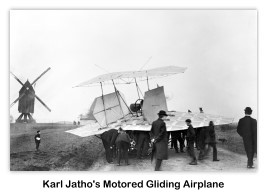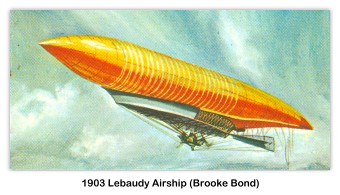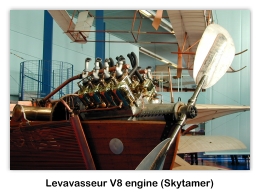

| 1902 | Master Index | 1904 |
1903 Chronology of Aviation History
Major Aviation Events
January 1903
-
January 1903 (Paris, France) — Alberto Santos-Dumont announces that all passengers in the dirigible airship N° 10 that he is currently constructing will in the future be charged on a strict price to weight ratio of one franc per kilogram. [1]
-
1 January 1903 (Russian Empire) — Konstantin Tsiolkovski deduces the Basic Rocket Equation. Konstantin Eduardovich Tsiolkovsky (17 September 1857 - 19 September 1935) was an Imperial Russian and Soviet rocket scientist and pioneer of the astronautic theory. Along with his followers the German Hermann Oberth and the American Robert H. Goddard, he is considered to be one of the founding fathers of rocketry and astronautics. His works later inspired leading Soviet rocket engineers such as Sergey Korolyov and Valentin Glushko and contributed to the early success of the Soviet space program.
 His most important work, published in 1903, was The Exploration of Cosmic Space by Means of Reaction Devices Tsiolkovsky calculated, with the Tsiolkovsky equation, that the horizontal speed required for a minimal orbit around the Earth is 8,000 m/s (5 miles per second) and that this could be achieved by means of a multistage rocket fueled by liquid oxygen and liquid hydrogen. In 1903 he published an article Investigation of outer space rocket appliances, in which for the first time it was proved that a rocket could perform space flight. In this article, and its subsequent sequels in 1911 and 1914, he developed some ideas of missiles and the use of liquid rocket engine. [3,5]
His most important work, published in 1903, was The Exploration of Cosmic Space by Means of Reaction Devices Tsiolkovsky calculated, with the Tsiolkovsky equation, that the horizontal speed required for a minimal orbit around the Earth is 8,000 m/s (5 miles per second) and that this could be achieved by means of a multistage rocket fueled by liquid oxygen and liquid hydrogen. In 1903 he published an article Investigation of outer space rocket appliances, in which for the first time it was proved that a rocket could perform space flight. In this article, and its subsequent sequels in 1911 and 1914, he developed some ideas of missiles and the use of liquid rocket engine. [3,5]
February 1903
-
12 February 1903 (Dayton, Ohio) — The world's first successful heavier-than-air aircraft engine, which will power the Wright brothers' first airplane in December 1903, runs for the first time in Dayton Ohio.[3]
-
16 February 1903 (Paris, France) — Traian Vuia presented to the Académie des Sciences of Paris the possibility of flying with a heavier-than-air mechanical machine and his procedure for taking off, but it was rejected for being an utopia, adding the comments: “The problem of flight with a machine which weighs more than air can not be solved and it is only a dream.” [3]
March 1903
-
23 March 1903 (Dayton, Ohio) — Orville and Wilbur Wright applied for patent on their flying machine based on the design of their Glider No. 3. (Patent issued 22 May 1906.) [2,3]
-
31 March 1903 (Timaru, New Zealand) — Richard Pearse is reputed to have made a powered flight in a heavier-than-air craft, a monoplane of his own construction, that crash lands on a hedge. Richard William Pearse (1877-1953) was the son of Cornish immigrants from St. Columb near Newquay, a New Zealand farmer and inventor who performed pioneering experiments in aviation. According to witness statements, Pearse flew and landed a powered heavier-than-air machine on 31 March 1903, some nine months before the Wright brothers flew their aircraft. The documentary evidence to support such a claim remains open to interpretation, and Pearse did not develop his aircraft to the same degree as the Wright brothers, who achieved sustained controlled flight. Pearse himself was not a publicity-seeker and also occasionally made contradictory statements which for many years led some of the few who knew of his feats to offer 1904 as the date of his first flight. The lack of any chance of industrial development, such as spurred the Wrights to develop their machine, seems to have suppressed any recognition of Pearse's achievements. The machine made a flight claimed to be around 150 feet (45 m) on his farm at Upper Waitohi, near Timaru in south Canterbury, New Zealand. [3,6]

April 1903
-
2 April 1903 (Paris, France) — Wright secrets are revealed to French. A lecture to the Aéro-Club de France by scientist and engineer Octave Chanute, born in Paris but now living in Chicago, has alarmed his former compatriots, who are anxious that the secret of heavier-than-air flight is about to be discovered in the United States.
Chanute described the American Wright brothers' successful glider trials last year, focusing on their simultaneous use of the rudder and the complex wing-twisting mechanism for flight control. This was largely dismissed, but their generally advanced work has aroused much concern. [1]
-
16 April 1903 (Portsmouth, England) — Samuel F. Cody barely escapes with his life during the naval trials of his man-carrying kite when the Captain of HMS Seahorse, forgetting that the ship must tow the kite into the wind, turns, and both Cody and his kite are flung into the water. [1]
May 1903
-
8 May 1903 (Moisson, France) — Yellow airship makes historic round trip. Huge crowds turned out today to witness to the Lebaudy airship making the first fully controlled aerial journey in history. Nicknamed Le Jaune [The Yellow One], the Lebaudy crewed by Georges Juchmès and a colleague, left Moisson and flew towards Mantes, some 23 miles.
The 40-hp Benz engine work perfectly, allowing good progress against strong winds and a fairly easy journey to Château de Rosny, were maneuvering tests were held. The elevator and rudder gave excellent control, and the separation of gas into compartments prevented gas surging. The Lebaudy then returned to Moisson. Its sponsors are industrialists Paul and Pierre Lebaudy, and the designer is Henri Julliot. The first fully practical airship, it is a unique in being semi-rigid. [1]
-
11 May 1903 (New Zealand) — Richard Pearse is claimed to have made a flight of around 1,000-yards (900 m), landing in a semi-dry bed of the Opihi River. [3,6]
June 1903
-
6 June 1903 (Nice, France) — After several satisfactory stability trials, Ferdinand Ferber makes the first full trial of his glider N° 6. It fails to take off. [1]
July 1903
- No data
August 1903
-
8 August 1903 (Washington, DC) — Samuel Langley launches a quarter-scale model of his powered flying machine Aerodrome from a rail on the roof of a houseboat on the Potomac River. The flight covered a distance of 985 feet. [1,9]
-
18 August 1903 (Hanover, Germany) — Karl Jatho (1873-1933) was a German pioneer and inventor, performer and public servant of the city of Hanover. On August 18, 1903 he flew with his self-made motored gliding airplane 4 months before the first flight of the Wright Brothers. He made his first attempts with a plane with three lifting surfaces, but soon switched to two surfaces. They were modeled after the Zanonia seed, a seed known for its gliding capability. In contrast to the Wright Brother's planes, the wings were flat in profile and not curved. The plane was equipped with a single-cylinder 10 horsepower (7.5 kW) Buchet engine driving a two-bladed pusher propeller and made hops of up to 200 ft (60 m), flying up to 10 ft (3 m) high. In comparison Orville Wright's first controlled flight four months later was of 36 m (120 ft) in 12 seconds although Wilbur flew 59 seconds and 852 ft later that same day. He founded a flying school and a plane factory, but did not have much success. [1,3,7]

![Langley's quarter-scale model (Wikipedia photo [9])](https://www.skytamer.com/1903/Samuel_Pierpont_Langley_-_Quarterscale_model%2C_1896.jpg)
September 1903
-
25 September 1903 (Kitty Hawk, North Carolina) — The brothers Orville Wright and Wilbur Wright arrive at Kitty Hawk, North Carolina from Dayton, Ohio to begin tests of their first powered aircraft. [1]
October 1903
-
7 October 1903 (Widewater, Virginia) — Langley's flight ends in damp disaster. Astronomer Samuel Langley, considered by many to be the United States' best hope to gain the honor of staging the first powered flight, lost his machine and very nearly his pilot this morning in the swirling waters of the Potomac River.
Langley's Aerodrome, a tandem-winged monoplane powered by a 52-hp gasoline engine and made a wood with steel tubing, was launched from a catapult runway placed on top of a houseboat, but it did not fly at all before plunging into the water.
Reports say that the catapult fouled the Aerodrome on takeoff, but some observers think that this was perhaps a fortunate accident, as the inevitable breakup of the machine at least took place close to the houseboat, improving the chances of rescuing pilot Charles Manly safely. Despite this disappointment Langley hopes to try again after rebuilding the wrecked machine onshore. [1,3]
-
October 1903 (Perth, Western Australia) — It is reported that a Mr. A. Barr of Doodlekine, Western Australia, has patented a flying machine that will be used for military purposes. [1]

November 1903
-
3 November 1903 (Paris, France) — Gustave Eiffel proposes that the Aéro-Club de France should set up a flying field on the Champ-de-Mars at the foot of the Eiffel Tower, with a cable for aviators to hoist themselves up to the first stage of the tower for takeoff. [1]
-
6 November 1903 (Dover, Kent, England) — Kite-powered boat crosses the Channel. Samuel F. Cody landed here at 8:30 a.m., 13 hours after leaving Calais in a tiny boat towed by one of his large kites, which acted as a kind of sail to catch the wind. He went to France yesterday by the by the Channel packet, with his boat and two kites (one spare), all made in his Alexandria Palace, London, workshops. He also had a hurricane lamp and a set of oars. He left Calais around 7:30 p.m. yesterday in good weather, but the wind dropped and he had to haul down the kite and drift for a while. The wind freshened up after sun-up and brought him safely to Dover. [1]
-
12 November 1903 (Moisson/Paris, France) — The Lebaudy brothers make a controlled dirigible flight of 54 km (34 miles) from Moisson to Paris, France. [3,4]
-
19 November 1903 (France) — Léon Y. K. Levavasseur demonstrates his Antoinette engine, designed as a lightweight powerplant specifically for aircraft.
Léon Levavasseur (1863-1922) was a powerplant engineer, aircraft designer and inventor. His innovations included the V8 engine, direct fuel injection, and evaporative engine cooling. Primarily associated with the Antoinette company, he continued to experiment with aircraft design after the company went bankrupt.
Levavasseur was born in Le Mesnil-au-Val, Cherbourg, France to a naval officer. Initially studying fine arts, Levavasseur switched to studying engineering, with a particular interest in arc lamps and petrol engines.
In the summer of 1902, Levavasseur suggested to industrialist Jules Gastambide that powerful, lightweight engines would be necessary for powered flight, and proposed the manufacture of these engines. He also proposed that the engines be named after Gastambide's daughter, Antoinette. Gastambide financed the venture. Levavasseur patented the V8 engine configuration that year. By 1904, most of the prize-winning speedboats in Europe were powered with Antoinette engines.
During this time, he designed engines of various configurations of up to thirty-two cylinders. The Antoinette company was incorporated in 1906, with Gastambide as president and Levavasseur as technical director. The vice-president was aviation pioneer Louis Blériot. The company's primary business was the sale of engines to aircraft builders. Levavasseur's Antoinette engines often included advanced features, including direct fuel injection and evaporative engine cooling. [3,4,8]


December 1903
-
December 1903 (Le Havre, France) — Light, high-powered engine attracts praise. Great excitement in aviation circles has greeted the recent development of the Antoinette engine, designed by Léon Levavasseur. Named after the daughter of industrialist Jules Gastambide, who sponsored his development, it is very light weight and high power may be the breakthrough needed to produce a practical powered airplane.
Also at Gastambide's expense, Levavasseur has built an airplane to use the engine, but it failed to fly during trials at Villorran near Chantilly. This has not dampened enthusiasm for the engine. Levavasseur received patents for his engine on August 28. Two models have been perfected so far, producing 24-hp and 50-hp. The larger weighs only 344-lbs.
The water-cooled Antoinette has machine-steel cylinders with brass water jackets, arranged as an eight-cylinder “V”. The big-ends are placed side-by-side on four crankpins. Instead of a carburetor, a manifold pipe leads to each cylinder, through which gasoline drips into a tiny funnel on each cylinder. After turning the valve on, gasoline vapor and air are sucked in at the induction stroke. [1]
-
8 December 1903 (Washington, D.C.) — On this date, a second attempt was made by Charles Manly to fly Langley's repaired full-sized aerodrome. As with the October 7 attempt, the machine failed to fly, tripping on its launch gear and somersaulting into the Potomac River nearly killing Manly. A surviving photograph captures the machine upended on its side as it falls off the houseboat. Langley himself was absent in this attempt. The machine's failure to fly ended his government (U.S. Army) funded attempts at building a successful full-size man-carrying flying machine. [3]
-
14 December 1903 (Kitty Hawk, North Carolina) — The first test of the Wright brothers' Flyer ends in disappointment. The machine sinks to the ground when Wilbur, at the controls, pulls to sharply on the elevator. [1]
-
17 December 1903 (Kitty Hawk, North Carolina) — First sustained controllable flight of powered heavier-than-air machine by Orville and Wilbur Wright. [2]
-
17 December 1903 (Kitty Hawk, North Carolina) — Dream comes true as Wright ‘Flyer’ leaves ground. A dream as old as history has been fulfilled, and man has conquered the air. At 10:35 this morning in North Carolina, the Wright brothers realized their ambition to make the world's first powered flight.

The Wrights' machine, now called the Flyer, took off for the first time from a 40-foot wooden rail laid out on level ground near their camp at Kill Devil Hill. With Orville at the controls, the Flyer rose into the strong, buffeting winds for a flight of 120-feet that lasted 12-seconds. The five witnesses, all local men, were not particularly impressed, as they had seen the Wright brothers make much longer flights in their gliders over the last two years. But the Wright brothers were delighted, because they believed they had found the key to building a practical flying machine.
They made four flights in all, the last by Wilbur at noon. He flew for 59-seconds and covered 852-feet. The Flyer was then damaged when a gust of wind flipped it over before the fifth flight could be made. The Wright brothers decided to call it a day and hurried to telegraph the news to their father in Dayton.
The Wright brothers' scientific approach to their work enabled them to succeed where others have failed. In a short four years of gliding among the storm-battered dunes near Kitty Hawk, they have never taken unnecessary risks, always seeking to understand what they were doing before attempting it, and Backing up their efforts with a firm grasp of aerodynamic theory.
Tests carried out last fall were very successful, and the Wright brothers spent the winter at their bicycle workshops in Dayton developing a suitable engine and propellers to power the Flyer. But on arriving at Kitty Hawk three months ago to start powered experiments, they suffered a series of delays which made them fear that they would be beaten into the air by Samuel Langley. When his Aerodrome crashed in the Potomac on December 8, they knew they still had a chance.
Winter was closing in. They had promised to be home for Christmas, but were also determined to fly. The first try was on December 14. The Flyer left the track but fell Back to the ground, Wilbur was not used to the controls. Repairs were completed yesterday, but the wind was too light. Today conditions were almost ideal … and the Wright brothers made history. [1]
Works Cited
- Gunston, Bill, et al. Chronicle of Aviation. Liberty, Missouri: JL Publishing Inc., 1992. 14-17
- Parrish, Wayne W. (Publisher). "United States Chronology". 1962 Aerospace Yearbook, Forty-Third Annual Edition. Washington, DC: American Aviation Publications, Inc., 1962, 446-469.
- Wikipedia, 1903 in aviation
- Shupek, John (photos and card images), The Skytamer Archive. Skytamer.com, Whittier, CA
- Wikipedia, Konstantin Tsiolkovsky
- Wikipedia, Richard Pearse
- Wikipedia, Karl Jatho
- Wikipedia, Léon Levavasseur
- Wikipedia, Samuel Pierpont Langley
Copyright © 1998-2018 (Our 20th Year) Skytamer Images, Whittier, California
ALL RIGHTS RESERVED


























